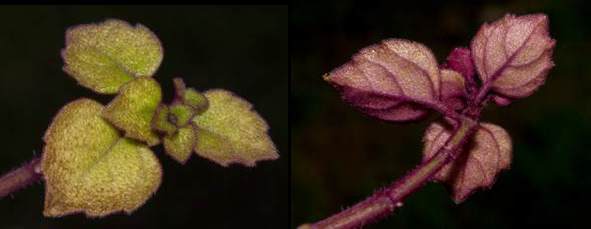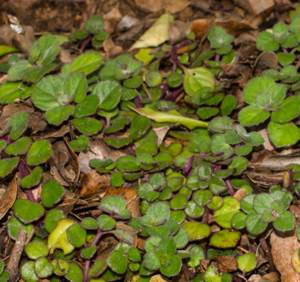Plectranthus strigosus
Plectranthus strigosus Benth.
Family: Lamiaceae
Common names: dwarf spurflower; dwerg spoorsalie (Afr.)
Introduction
A dainty and delicate ground cover for shade gardens or hanging baskets.

Description
Description
Plectranthus strigosus is a semi-succulent perennial herb. Like most members of the Lamiaceae family, the young branches are square in cross-section and the leaves are opposite. Both branches and leaves are covered in diagnostic tiny rusty red hairs. In the shade, the leaves are typically fresh-green, broadly ovate, ranging in size from 15-35 mm in diameter, shallowly scalloped along the margins and either pointed or rounded at the tip. In the sun the leaves stay small, become maroon and slightly more succulent.

The inflorescence is a short, erect raceme arising from the tips of the growing stems, 30-120 mm long, often with a pair of side branches. Calyces at the base of flowers are green, fading to purple at the mouth, 3mm long at flowering and enlarging to 5-7 mm after flowers drop. The small white flowers are 10-12 mm long with a distinct swollen section at the base, narrowing to a throat and then flaring slightly at the mouth.

The brown seeds or nutlets are 1mm long and nested in the base of calyces. The flowering period is remarkably long, starting in spring (September) and lasting until early winter (May) with a peak in April (in the southern hemisphere). Although the flower size is relatively small for the genus, healthy specimens can produce staggering quantities of flowers creating an impressive show.
Conservation Status
Status
This species is currently not recognised as being threatened in the wild.
Distribution and habitat
Distribution description
This species is restricted to the Eastern Cape province of South Africa, its distribution being somewhat fragmented resulting in local variability in its habit. It grows on well-drained humus rich soils on rocky ridges in heavily shaded kloofs and forests.
Derivation of name and historical aspects
History
The specific name strigosus refers to the fine rusty reddish hairs that cover the young stems and leaves (especially the back of the leaves) giving it a somewhat purplish/reddish colouring. The first collection of the species, in 1813, was by plant collector and explorer William Burchell in the district of Bathurst in the Eastern Cape.
Plectranthus is an Old World genus of about 350 species inhabiting warm tropical and subtropical climates, principally in the southern hemisphere. Its range extends from sub-Saharan Africa through Madagascar, India and the Indonesian archipelago, down to Australia and some Pacific islands. There are 53 species distributed in South Africa. The genus is closely related to the genus Solenostemon.
Ecology
Ecology
In warm tropical climates, growth is rapid all year round, but in sub-temperate climates growth rate slows down with dropping temperatures and can stagnate in winter. Plants root readily at the nodes as it creeps along the ground and as such, is constantly replenishing itself in areas where it has died off, the result being that, even though a herb, it can be quite long-lived.
Plectranthus strigosus seems to be able to morph its physiology depending on where it grows, either on damp, shady forest floors, or exposed rocky ledges, becoming more or less succulent as needed. The pollinator is not known.

Uses
Use
In frost-free, sub-temperate and subtropical climates, Plectranthus species are universally recognised as excellent shade plants. They are also often used as house plants, and will usually thrive in deep shade where many plants struggle for lack of sunlight. Perhaps lesser-known than most Plectranthus species, P. strigosus makes an attractive, very low-growing mat-forming ground cover that is well-suited to very shady areas.
Ths species has no known cultural uses.
Growing Plectranthus strigosus
Grow
This species is versatile as a horticultural subject, lending itself to being grown in shady rockeries, as a bedding plant along edges, or as a pot subject. They make for especially striking hanging basket displays.
Plectranthus species are among the easiest and most rewarding of all plants to cultivate and this species is no exception. Cuttings can be made at any time of the year, but preferably in summer, consisting of short pieces of stem with about 3 or 4 nodes. Strip the leaves from the lower 2-3 nodes leaving only about 4-6 leaves at the top of the cutting. No rooting hormone is required. During the cool months of autumn, winter and spring, the cuttings can be stuck directly into the ground where you ultimately want the plant to grow. This method works as long as the cuttings are watered every two days or so during the first two months. Alternatively, cuttings can be stuck in any rooting medium in pots or cutting trays under the protection of a nursery structure or propagation bench with regular watering or misting.
Sow fresh seed in a well-drained seedling mix and cover very lightly with a thin layer of pure sand. This can be done at any time of the year but the warmer summer months are best. Seedlings often outgrow cuttings of the same age and are often more robust and better-branched in their growth habit. The seedlings should be pricked out when they are a few months old and either planted into the ground or potted up.
Although a delicate and diminutive plant by nature, its growth is relatively rapid and, if planted in spring, they should form a dense mat by mid-summer and will certainly flower the same season. If growth is untidy, they should be pruned back lightly after flowering and in spring . Feeding with a good layer of compost and/or organic fertiliser will stimulate vigorous growth. They will sprout vigorously again in early spring. They require very little other maintenance apart from fairly regular watering at least once a week. Caterpillars, snails and builders' work boots seem to be its only real enemies.
References
- Van Jaarsveld, E. 2006. The Southern African Plectranthus : and the art of turning shade to glade . Fernwood Press, Cape Town.
Credits
Adam Harrower
Kirstenbosch National Botanical Garden
April 2014
Plant Attributes:
Plant Type: Ground Cover, Perennial
SA Distribution: Eastern Cape
Soil type: Sandy, Loam
Flowering season: Spring, Early Summer, Late Summer, Autumn
PH: Acid, Neutral
Flower colour: White
Aspect: Shade
Gardening skill: Easy
Special Features:
Horticultural zones









Rate this article
Article well written and informative
Rate this plant
Is this an interesting plant?
Login to add your Comment
Back to topNot registered yet? Click here to register.